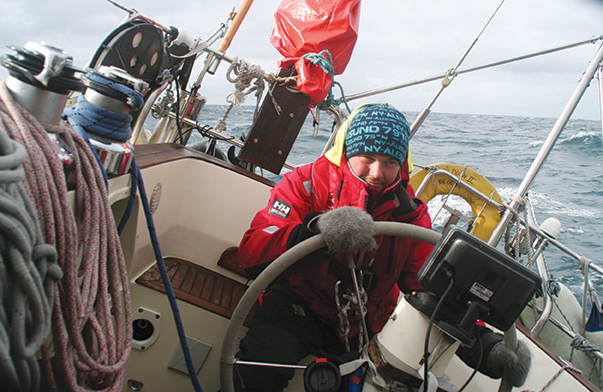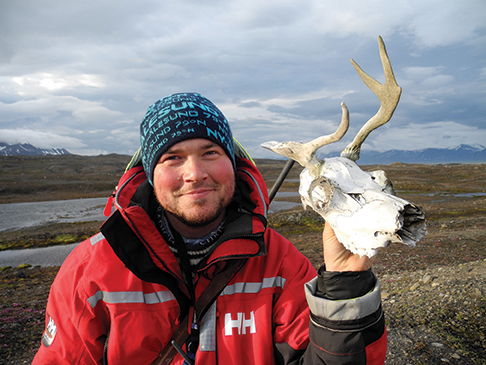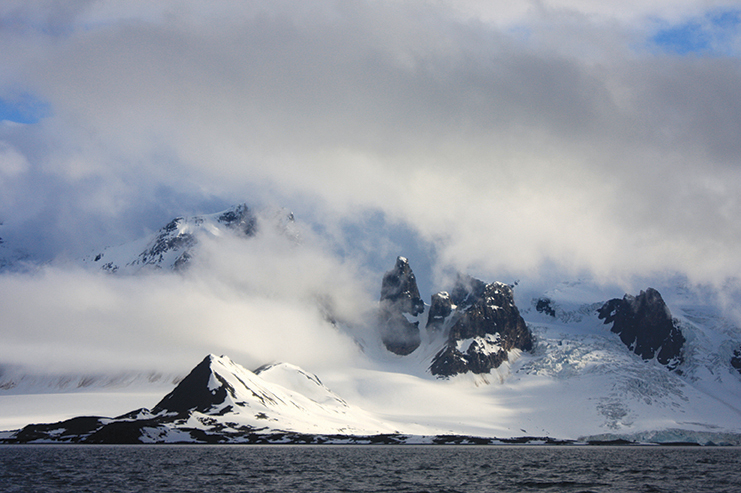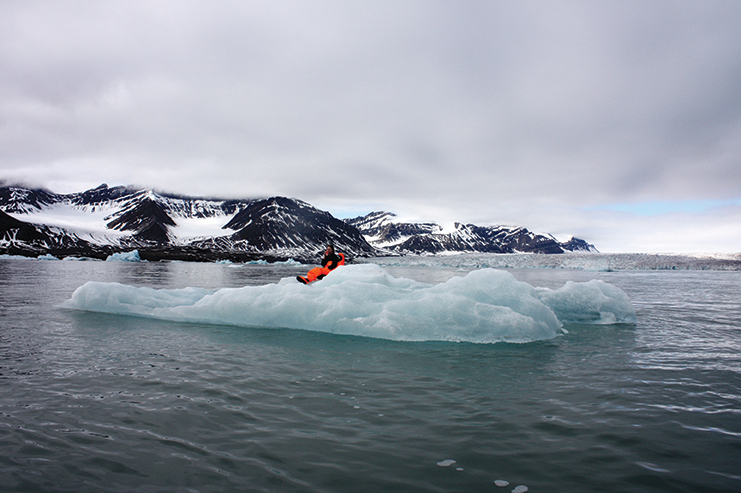Questions abound as a dream voyage to Svalbard is realized (published August 2014)
When I decided to sail to the Norwegian archipelago of Svalbard, located in the Arctic Ocean halfway between mainland Norway and the North Pole, a host of initial questions arose and many more followed. How much would it cost? What requirements must the boat and crew meet before undertaking such a cruise? What would we do about polar bears…and ice?
Through meticulous research and a little bit of finding out as I went, I was able to uncover the answers to these questions and more in order to fulfill my dream expedition to the Arctic aboard my yacht Duen II.
PREPARING FOR THE TRIP
At the end of summer 2012, I started my preparation for an expedition to Svalbard by acquiring the Arctic navigation rules, finding crew, getting insurance, and of course, the necessary and required equipment. But if I decided to equip my boat with all the gear that I found useful, I’d probably need a tugboat to accommodate it all, not Duen II, which measures just 38 feet. Therefore, it was necessary to find a compromise on a number of accessories for the trip in order to achieve my arctic dream.
Among many other upgrades to my yacht, there were a few things that absolutely had to get done before we could head north. Although I had an EPIRB and a life raft, it turned out that they were too old to get serviced, so I ordered a brand new six-man raft and EPIRB from Seatronics. Also, I didn’t want to rely on the engine alone to recharge my electrical system. Instead, I opted to buy and install a wind generator and to renew the battery bank. And I bought a used satellite phone from a fellow long distance cruiser.
Working on a rotating system every six weeks on board the Norwegian tall ship Christian Radich, I spent most of my days off preparing the boat, searching for crew, exploring the literature about Arctic shipping and contacting people who had voyaged to the areas I wanted to go.

After some searching, I found the crew: Even, Hanne, Helge, Toril and Harald. Not all of them could afford to take part in the entire five-week expedition, so it quickly became clear that we would need to organize a crew change in Longyearbyen. So I found the rest of the crew via websites and Facebook.
Finding the adventurers willing to experience the arctic sailing was not my biggest challenge. In my mind existed still another problem—ice. Experienced sailors repeated like a mantra, “avoid ice, avoid ice!” Yet they offered very little in the way of constructive comments. Which left me with the question: how do I avoid ice while sailing in the Arctic? It was a question I would have to answer myself.
After a thorough study of Norwegian Pilot book number 7, containing the Svalbard and Jan Mayen areas, I realized that the current around Svalbard runs in a consistent clockwise direction. So it stands to reason that the ice moves in the same direction. The situation would seem to be the safest when the wind blows from land, but as it turned out, even then it was possible to encounter drifting ice in the other direction. Therefore, to predict how the ice would move, it was necessary to closely follow local weather forecasts and to be constantly vigilant.
Another question that arose was how to deal with the threat of polar bears. Before finding crew, I thought a lot about equipping Duen II with weapons to protect us from bears. But I didn’t have to worry much about this, as two of my crewmembers were experienced hunters and brought their own rifles for just this purpose. While to some this may seem an unnecessary precaution, the possession of a weapon during the expedition is an obligation imposed by the Governor. However, it must not be used for wanton killing of animals. Firing shots at a polar bear should be done only in extreme distress as self-defense.

BUREAUCRACY & INSURANCE
Svalbard is not part of any Norwegian county, and is therefore administered by a state-appointed governor. Before we left I wrote an email to the Governor of Svalbard and expected to meet a cumbersome bureaucratic process. This was fortunately not the case. Instead, I was met with understanding and helpful people who rendered great service. As the freedom-loving sailor that I am, I wrinkled my nose at having to fill out a report form describing my itinerary and at having to buy additional “Search and Rescue Insurance” to be able to legally travel outside the ice fjord (the fjord where Svalbard’s capitol, Longyearbyen, is). But when the Governor’s representative explained to me how many resources go into looking for lost adventurers, I understood.
I called my insurance company, Gjensidige, twice and they told me that my insurance covered the voyage. But when I asked them to email the Governor’s office to inform them that I was covered, it became evident that I was not sufficiently insured. Just before departure I ended up having to pay 13,500 Norwegian Krones (USD 2,250) to update my insurance for the voyage.
OFF TO BEAR ISLAND
From Valvåg in south Senja, Norway, we motored north to Tromsø to top up our tanks with diesel and water. We then went on to Torsvåg, where the Torsvåg lighthouse was our last landmark on mainland Norway before we headed to Bear Island (Bjørnøya). The feeling of leaving the mountains and fjords to sail straight into the Barents Sea was indescribable. Although we had headwinds and some seas, it was not too much of a problem for our crew.
But our pride stood to fall. At the end of my first watch came the first bout of seasickness for the crew in the cockpit. Hanne was slightly reduced and sick. Helge was also somewhat low. And drinking water didn’t really help, because even though it warmed the body, after a while it just came back out.
After more than two consecutive days of seasickness the wind eased and the sea calmed down a bit, which gave us a chance to finally eat a proper meal. Soon after, we saw the first outlines of a characteristic mountain known as Miseryfjelle—Misery Mountain. We decided to anchor at Sørhamna to wait for a favorable wind, as we did not have enough fuel to get us all the way to Longyearbyen. The days spent at anchor were used for maintenance and walking trips in the countryside.
Bear Island is the southernmost part of the Svalbard archipelago and is located roughly halfway between Spitsbergen (the largest island in the Svalbard archipelago) and Tromsø. Bear Island can best be described as a fairly barren but picturesque place where the only residents are scientists from the meteorological station. And since 2002, the island is also a nature reserve.
LONGYEARBYEN & CIVILIZATION
After five days the wind finally dialed in the preferred direction for us, allowing Duen II to continue sailing north. I smiled broadly as we reached a top speed of over 10 knots, but the sailing was tiring for all and we were relieved to finally relax when we reached the marina in Longyearbyen. Though all of us appreciated the rest, because we were no longer standing a constant watch, our thoughts were far from Longyearbyen. Questions of going north appeared in all of our minds: How far north could we go? Would it be possible to achieve 80 degrees north latitude?
However, we did not avoid problems when a homesick crewmember decided to depart, which complicated our situation. But even though we were now left with only three crewmembers, we all wanted to continue.

Continuing our expedition to Ny-Ålesundu was fairly straightforward. The transition through the Forlandssundet channel was narrow and mostly covered with dense fog. And with help from the chartplotter and radar we were able to safely transit the narrow and potentially dangerous pass.
We encountered ice for the first time while sailing into Kongsfjord. Volkswagen-sized lumps seemed to doze lazily in the surrounding water. We remained calm, while at the same time increasing our vigilance. It was an annoyance to no longer have a fourth member of the crew, which meant another set of eyes to watch for ice, but we managed to successfully maneuver between ominous fragments of icebergs and moved steadily towards Ny-Ålesund.
NY-ÅLESUND
On June 22, 2013 we motored into Ny-Ålesund, one of the northernmost settlements in the world. Ny-Ålesund is a research town that houses research stations that are part of the Global Atmosphere Watch. In the winter there are 30 permanent residents and in the summer the population swells to 130.
After we moored I didn’t get much rest before Hanne’s voice woke me up. As it turned out, the harbormaster wanted us to move because we were going to end up anchored close to a local cruise ship. In sleepless desperation, I went out on deck and informed the charming female harbormaster that we were unable to start the engine due to a malfunction and went back to sleep. But it did not last long, as the cruise ship, called Costa Pacific, soon showed up next to us with swarming crowds of passengers. And when one of the tenders maneuvered close to Duen II I regretted not succumbing to the earlier request of the harbormaster.
When the risk of crushing our boat passed, friendly locals invited us to a rock music festival held that evening in Ny-Ålesund. It should come as no surprise that clothing to attend a concert did not appear in the list of top 50 most important things to have aboard Duen II before the Arctic expedition. Despite this, we decided to improvise and did our best to look presentable for the event. The concert was full of delicious food and good spirits, and the villagers turned out to be extremely friendly and generous.

TO THE ICE FJORD
After Ny-Ålesund, our first stop was back south to Farmhamna. There we met a 22-year-old named Andreas who lives alone in a hunting cabin. He was a real trapper. Many hunting and fishing enthusiasts may dream of living alone for a year or two to live off of what they catch. It is rare, though, when someone completely and actually realizes this dream.
From here we said goodbye to our benevolent trapper and sailed into the Ice Fjord, in the direction of the Svea Glacier. The glacier lay at the head of the fjord in all its glory, with some small icebergs leisurely bobbing around. Hanne and I set out in the dinghy to take a look and we zigzagged between small icebergs until the ice was so thick that we couldn’t get any closer. We turned off the outboard engine and sat nestled in the dinghy staring up at the glacier as if we were in a trance. All around us we heard sounds of the ice crackling and dripping as it slowly melted in the sun. Birds sat quietly looking at us weird creatures and a seal circled. Life could not have been much better than this.
Suddenly, we heard a full-blown roar and boy did we see a real calving! A portion of the glacier the size of a trailer fell into the water 100 yards from us in the dinghy, which made the return trip to Duen II a bit more exciting. The icebergs had leisurely moved and now hid the exact placement of the boat. But we were not nervous, as we slowly but surely discovered her amongst the ice.
PYRAMIDEN & NEW CREW
Our stop at the Svea Glacier only lasted one day and on June 26 we headed toward the farthest village within the central branch of Ice Fjord—the mysterious Pyramiden. This small town is a former Soviet mining village and has been almost completely depopulated. Walking around the abandoned village with our rifles, we felt like we had arrived after an apocalyptic disaster, as the scenery resembled images from a science fiction movie.
When our crewmember left us in Longyearbyen, I placed an ad on the Internet searching for a replacement and two people decided to join us—an Irishman and a lady from Tromsø. As a responsible skipper I had a long discussion with myself, wondering if I should bring on two people who I had never met before, relying solely on their own opinions regarding their sailing skills. They both assured me of their rich sailing experience and I agreed to pick them up in Longyearbyen.
On the last day of June, and after the crew change, we left Longyearbyen and sailed towards Bellsund, stopping along the way in Cole Bay and Barentsburg. The weather was so bad that we could not dock in the marina, so we spent two days at anchor in Fridtofhamna where unfavorable conditions stopped us until July 4th.

HORNSUNDET & HOME
After leaving the anchorage in Bellsund in poor conditions, we sailed in the direction of the next fjord, Hornsundet, on the south end of Spitsbergen. Depending on the wind direction, we moved around between two anchorages: Isbjørnhama and Gåshamna. The most beautiful and the most exciting was the stop at Isbjørnhama.
We had become accustomed to waiting for a change in wind direction and it was the same this time when the weather stopped us for two days at anchor. Dense fog surrounded us and the wind reached over 25 knots. The weather was not good enough to get out in the dinghy and the crew stayed busy aboard by making necessary repairs, baking bread, reading books and watching movies. And perhaps above all, sleeping.
On July 8 we were at last able to start sailing back toward Bear Island and then Tromsø, and Duen II began to slowly show signs of fatigue over the month of Arctic sailing. We lost our rudder indicator and closer to Tromsø the autopilot stopped working all together. The autopilot failure forced us to manually steer and I was happy to have welcomed the extra crew.
The weather was beautiful and sunny on July 12 when we moored in Tromsø and celebrated the end of our trip with champagne and fruit. I was proud and happy to have reached my goal, and, above all, to have returned home safely. Although the trip did cost quite a bit, which I had planned for earlier, I am left with a passion for the Arctic and am sure that I will return to Svalbard, as there is so much left to discover of this amazing place.

Twentynine-year-old Øyvind Nilssen is from Senja, Norway and has been working at sea over 10 years. He graduated from the Norwegian Maritime School and currently works on board the Norwegian tall ship Christian Radich. He plans to begin a circumnavigation aboard his boat Duen II in the near future. Contact: group on facebook S/Y Duen, Blog: http://syduen.blogspot.com/















